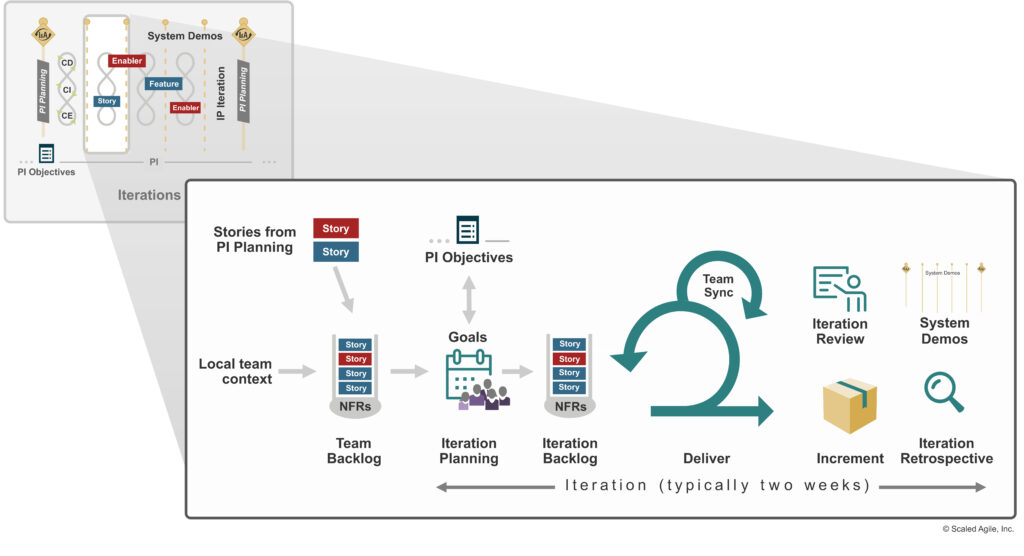Introduction:
In today’s dynamic business environment, organizations are increasingly adopting Agile methodologies to enhance productivity, foster innovation, and deliver exceptional value to customers. However, scaling Agile practices across large enterprises requires a comprehensive approach. Enter the Scaled Agile Framework (SAFe), a widely embraced framework that enables organizations to effectively scale Agile practices from teams to the enterprise level. At the core of SAFe are the Five Levels, each offering a distinct focus and set of practices. In this blog post, we will delve into the Five Levels of SAFe and explore their contributions to achieving enterprise agility and success.
image credits to: Scaled Agile
Level 1: Team
At the Team level, SAFe concentrates on empowering individual Agile teams to deliver value. Agile teams collaborate in iterative and incremental ways, utilizing methodologies such as Scrum or Kanban. Emphasis is placed on continuous integration, automated testing, and shared code ownership to ensure efficient and high-quality delivery.
Level 2: Program
The Program level in SAFe centers around coordinating multiple Agile teams that work towards a common mission or product. The Agile Release Train (ART) acts as the primary organizing structure, aligning teams, synchronizing their efforts, and facilitating efficient delivery. Features and user stories are prioritized, planned, and delivered within Program Increments (PIs), enabling a continuous flow of value.
Level 3: Value Stream
The Value Stream level focuses on optimizing the end-to-end flow of value across the enterprise. It encompasses multiple Agile Release Trains and involves stakeholders responsible for delivering a solution. SAFe promotes a customer-centric approach, ensuring that value streams are fine-tuned to effectively meet customer needs. Value Stream Engineers and Product Management collaborate to identify value streams, eliminate bottlenecks, and streamline the flow of value from ideation to delivery.
Level 4: Large Solution
The Large Solution level zeroes in on developing and delivering complex, interconnected solutions that necessitate coordination across multiple value streams. It involves integrating multiple ARTs and engaging with suppliers to foster seamless collaboration. Agile Portfolio Operations play a pivotal role in aligning business strategy, managing dependencies, and facilitating the successful delivery of large-scale solutions.
Level 5: Enterprise
At the Enterprise level, SAFe addresses strategic agility and organizational transformation. It entails aligning business strategy with the Agile delivery model, fostering a culture of continuous learning and improvement, and embracing Lean-Agile principles throughout the organization. Agile Release Trains are constantly evaluated and adjusted to align with evolving business needs, ensuring the enterprise remains adaptable, innovative, and customer-focused.
Benefits of the Five Levels of SAFe:
- Improved Agility: The Five Levels of SAFe enable organizations to scale Agile practices while maintaining agility at all levels. This ensures that the organization remains responsive to customer needs, market changes, and emerging opportunities.
- Enhanced Collaboration: SAFe fosters collaboration and alignment across teams, programs, and value streams, promoting a shared understanding of goals, dependencies, and priorities. This collaboration facilitates innovation, knowledge sharing, and collective problem-solving.
- Predictable Delivery: SAFe provides a structured approach to planning and executing work, enabling organizations to deliver value predictably and consistently. The use of Program Increments and synchronized planning brings visibility, transparency, and improved delivery outcomes.
- Efficient Resource Allocation: The Five Levels of SAFe optimize resource allocation by aligning teams and activities based on strategic priorities. This minimizes waste, eliminates duplicated efforts, and maximizes resource utilization across the organization.
- Continuous Improvement: SAFe nurtures a culture of continuous improvement by encouraging retrospectives, feedback loops, and frequent learning cycles. The iterative nature of SAFe empowers organizations to adapt and evolve based on market feedback, changing customer needs, and emerging technologies.
Conclusion:
As organizations strive for enterprise-wide agility, the Five Levels of SAFe provide a robust framework to scale Agile practices effectively. From empowering individual teams to aligning business strategy with Lean-Agile principles, SAFe offers a comprehensive approach to driving success in large-scale Agile transformations. By embracing the Five Levels of SAFe, organizations can unlock the full potential of Agile, achieve faster time-to-market, and deliver customer value with greater efficiency and effectiveness.










